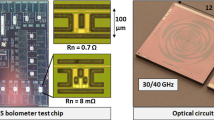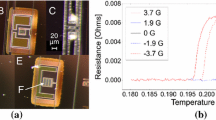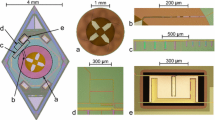Abstract
The reference design for the next-generation cosmic microwave background (CMB) experiment, CMB-S4, relies on large arrays of transition-edge sensor (TES) bolometers coupled to Superconducting Quantum Interference Device (SQUID)-based readout systems. Mapping the CMB to near cosmic variance limits will enable the search for signatures of inflation and constrain dark energy and neutrino physics. AlMn TESes provide simple film manufacturing and highly uniform arrays over large areas to meet the requirements of the CMB-S4 experiment. TES parameters such as critical temperature and normal resistance must be tuned to experiment specifications and can be varied based on geometry and steps in the fabrication process such as deposition layering, geometry, and baking time and temperature. Using four-terminal sensing, we measured \(T_\mathrm{C}\) and \(R_\mathrm{N}\) of AlMn 2000 ppm films and devices of varying thicknesses fabricated at Argonne National Laboratory to motivate device geometries and fabrication processes to tune \(T_\mathrm{C}\) to 150–200 mK and \(R_\mathrm{N}\) to \(\sim \)10 m\(\Omega \). Measurements of IV curves and time constants for the resulting devices of varying leg length were made using time-division SQUID multiplexing and determined \(T_\mathrm{C}\), G, k, \(f_{3\,\mathrm{db}}\), and \(R_\mathrm{N}\). We present the results of these tests along with the geometries and fabrication steps used to tune the device parameters to the desired limits.





Similar content being viewed by others
References
K.N. Abazajian et al., CMB-S4 Science Book, 1st edn. (2016). arXiv:1610.02743
M.H. Abitbol et al., CMB-S4 Technology Book, 1st edn. (2017). arXiv:1706.02464
K.N. Abazajian et al., CMB-S4 Science Case, Reference Design, and Project Plan (2019). arXiv:1907.04473
D. Li et al., AlMn transition edge sensors for advanced ACTPol. J. Low Temp. Phys. 184, 66 (2016). https://doi.org/10.1007/s10909-016-1526-8
S.-P.P. Ho et al., Highly uniform 150 mm diameter multichroic polarimeter array deployed for CMB detection, in Proceedings on Millimeter, Submillimeter, and Far-Infrared Detectors and Instrumentation for Astronomy VIII. SPIE 9914, p. 991418 (2017)
C.M. Posada et al., Fabrication of large dual-polarized multichroic TES bolometer arrays for CMB measurements with the SPT-3G camera. Supercond. Sci. Technol. 28(9), 094002 (2015). https://doi.org/10.1088/0953-2048/28/9/094002
J.A. Sobrin et al., Design and characterization of the SPT-3G receiver, in Proceedings on SPIE, vol. 10708 (2018). https://doi.org/10.1117/12.2314366
D.R. Schmidt, H.M. Cho et al., Al-Mn transition edge sensors for cosmic microwave background polarimeters. IEEE Trans. Appl. Supercond. 21(3), 196–198 (2011). https://doi.org/10.1109/TASC.2010.2090313
S.W. Henderson et al., Proc. SPIE 9914, 99141G (2016). https://doi.org/10.1117/12.2233895
B.J. Koopman et al., J. Low Temp. Phys. (2018). https://doi.org/10.1007/s10909-018-1957-5
J.R. Stevens, N.F. Cothard, E.M. Vavagiakis et al., J. Low Temp. Phys. (2019) (this special issue). arXiv:1912.00860
Acknowledgements
Work at Argonne, including use of the Center for Nanoscale Materials, an Office of Science user facility, was supported by the US Department of Energy, Office of Science, Office of Basic Energy Sciences and Office of High Energy Physics, under Contract No. DE-AC02-06CH11357. This material is based upon work supported by the National Science Foundation Graduate Research Fellowship Program under Grant No. DGE-1650441 (EMV) and NSF CAREER award No. 1454881 (MDN). Work by NFC was supported by a NASA Space Technology Research Fellowship.
Author information
Authors and Affiliations
Corresponding author
Additional information
Publisher's Note
Springer Nature remains neutral with regard to jurisdictional claims in published maps and institutional affiliations.
Rights and permissions
About this article
Cite this article
Vavagiakis, E.M., Cothard, N.F., Stevens, J.R. et al. Developing AlMn Films for Argonne TES Fabrication. J Low Temp Phys 199, 408–415 (2020). https://doi.org/10.1007/s10909-019-02281-9
Received:
Accepted:
Published:
Issue Date:
DOI: https://doi.org/10.1007/s10909-019-02281-9




